Portrait of a Cruiser: Alene D. Rice and Bruce Balan
(Apr 10, 2019) – An early love for travel and sailing lead both Alene and Bruce to set goals early in life towards a future in cruising, and both found means to make this passion a reality in their 40s. Now full-time seasoned sailors with many ocean miles behind them, the couple talk about their experiences past and present and the moments that keep them inspired.
Published 7 years ago, updated 6 years ago

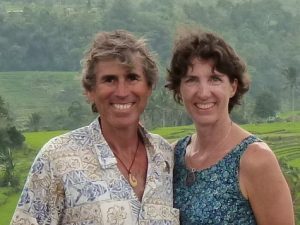
- Alene and Bruce in Bali – 2012
Names of Owners: Alene D. Rice and Bruce Balan
Nationality: USA
Boat Name: Migration
Boat Type: 1969 Cross 46 Trimaran
Home Port: Long Beach, CA, USA
Blog: http://brucebalan.com/migrations/
How did you start cruising?
Bruce: I learned to sail Sabots (a Southern California version of an Optimist) when I was 12. I fell in love with sailing and worked my way up to bigger boats. My parents bought a Catalina 27 and let me sail it on overnight trips to Catalina Island with my friends when I was 15. They were very trusting! Whatever guardian angel I had at the time ensured those were learning experiences and not disasters. When I was 14 I read The Dove by Robin Lee Graham; that put the spark in me. In my early twenties, I crewed on boats doing long passages (Mexico, Bermuda, Azores). It became my goal to save money, buy a boat, and go cruising. At 45 I quit my job and headed off.
Alene: When I was 25, I purchased an around-the-world ticket and backpacked for nearly two years. While in Fiji, I swam out to a boat at anchor and was invited aboard to rest before swimming back to shore. That was my first introduction to the cruising lifestyle, and I was smitten. Living aboard a boat and traveling held far more appeal than carrying a backpack and staying in hostels. At the end of my backpacking adventure, I purchased my first boat, lived aboard in San Francisco, and began socking away everything I earned to go cruising someday. I was able to achieve my goal of quitting work to begin sailing full-time at age 40.
Describe what sort of cruisers you are:
We are a full-time cruising couple. Migration is our only home.
What type of cruising are you doing currently?
In 2017 we completed a 60,000NM Pacific Circuit via Easter Island, Polynesia, New Zealand, Thailand, Japan, and Alaska. We are still bluewater cruising in the Pacific. We tell people we are sailing ‘around’ the world. We may circumnavigate someday, but for now, we’re happy just sailing around because there are so many wonderful places to stop!
What were the key reasons you selected your current boat?
Bruce: In the 1980’s I sailed on a Piver Victress from California to Mexico. I loved the way the trimaran handled downwind and how comfortable she was at anchor. After that trip, I knew I wanted to cruise in a trimaran.
Alene: I was sold on multihulls when I sailed on a Horstman trimaran in San Francisco Bay in 1989. It was just so comfortable to sail without heeling. And the owner of that tri convinced me with his adage, “I’d rather be upside down on top than right side up on the bottom.”
What other boats have you owned?
Bruce: I had a Sabot when I was a kid, and then a Hobie 14. Later, my parents had a Catalina 27.
Alene: My first boat was a Cross 26 trimaran. I traded that boat in for a Cross 36 a few years later. I lived aboard both boats at Pier 39 in San Francisco in the 1990s.
What changes have you made to your current boat?
Practically everything: engine, plumbing, wiring, electronics, instruments, standing and running rigging, sails, interior upgrades, galley. She was built with polyester resin and we’ve stripped the glass off the plywood and re-glassed her with epoxy. The wooden masts are original but we stripped them bare and painted them. Maybe we should have just built a boat…?
Most useful equipment fitted, and reasons for this choice:
- Solar Panels – Silent energy! Four 100-watt panels provide for everything we need, including refrigeration (we don’t have a freezer).
- Spectra 200C Watermaker – No more schlepping jugs of questionable water from shore. A wonderful invention. We love our older model that has less automation.
- Yanmar Engine (4HJ2-TE) – Reliable and easy to maintain.
- Monitor Wind Vane – Steers great, saves us a lot of power on passages, and is quiet.
- ICOM 406 HAM – Used primarily with our PTC-II for getting weather via Winlink and Sailmail.
- Lewmar V4 Windlass – When I was outfitting Migration I read an article that said, if you come into an anchorage exhausted late at night and aren’t happy with the set of your anchor, with an electric windlass you’ll pull it up, reset, and sleep well. With a manual, you might try to just get by. I like to sleep well.
Equipment regrets, or things you would do differently:
After owning Migration for 28 years, the things we don’t like have almost all been removed, remodeled, or replaced. However, we didn’t always get it right the first time. Often systems take multiple iterations before we succeed in figuring out a good solution. However, we do regret putting in Navman instruments and autopilot since the company was sold soon after and the products – and support – disappeared.

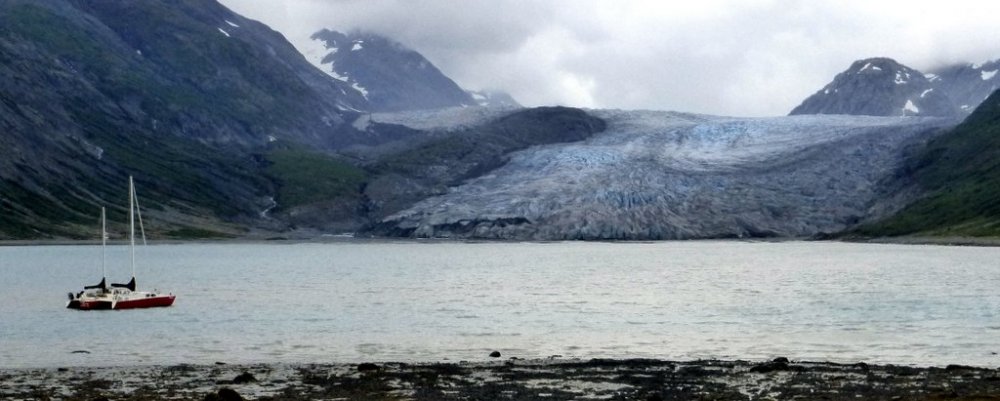
- Alaska – 2017
List the countries you have cruised:
USA (California, Washington, Oregon, Alaska), Mexico, El Salvador, Honduras, Nicaragua, Costa Rica, Ecuador (Mainland and Galapagos), Panama, Chile (Easter Island), Pitcairn, French Polynesia, Cook Islands, Niue, Tonga, New Zealand, Fiji, Vanuatu, Papua New Guinea, East Timor, Indonesia, Singapore, Malaysia, Thailand, Brunei, Taiwan, Japan, and Canada.
Before we were together, Bruce also sailed in Bermuda, The Azores, and Greece. Alene sailed in the Virgin Islands, Haiti, Jamaica, Cuba, the Cayman Islands, Columbia, Panama, Costa Rica, Honduras, Guatemala, Belize, the Bahamas, Turks and Caicos, Puerto Rico, and the length of the ICW.
Future cruising plans:
We’re heading back across the Pacific to French Polynesia in April 2019 and will meander for quite a while. We definitely want to return to Japan… although we won’t be doing the Aleutians and Alaska again… too cold! We want to revisit New Zealand, cruise Australia, and spend time in eastern Indonesia. Eventually, we’ll probably cross the Indian Ocean and go south around Africa. Too many choices!

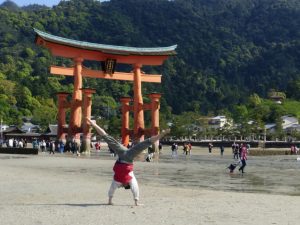
- Miyajima, Japan – 2017
List the oceans/seas you have crossed:
Bruce: Pacific both ways, Atlantic (USA to the Azores).
Alene: Pacific both ways, plus an earlier voyage from Hawaii to California.
Approximate sea miles: 75,000 NM
Scariest days on the water:
We sail fairly conservatively and check weather religiously; consequently, much to the disappointment of people we meet, we don’t have any ‘perfect storm’ horror stories. However, we did have a rather stressful departure from Pitcairn. We really wanted to go ashore despite knowing we would only have a few hours before the weather turned. We rushed back to the boat and began raising anchor just as Bounty Bay was becoming fully exposed. It was pouring rain, our cockpit was full of fruit, veggies, and coconuts from the Pitcairners, and we were both soaking wet and covered in mud. It was kind of exciting, but a bit stressful when the anchor briefly snagged on a rock.
Our first year sailing together we had a scary incident in the Sea of Cortez at the island of Salsipuedes, which roughly translates to “cannot leave.” We arrived close to evening on Alene’s birthday and could not find a place to get the hook to hold. We circled the small island trying different spots. Finally, as the light was failing, we were hurrying back toward the first spot we’d tried when… Crunch! Migration stuck fast on a rock. The depth sounder read 20 feet but we were on something. Wave action and full reverse got us off and we finally got the hook down in the dying light. Later we read in a cruising guide (the one we didn’t have at the time) about the dangerous unmarked pinnacle at that location. Luckily the damage was not significant.
But the absolute scariest moment was one I (Bruce) created. We had been in or out of the Motu Toopua anchorage at Bora Bora at least 5 times. We were heading back in through the marked channel in the late afternoon and I wanted to get the hook down so we could enjoy the sunset. I set the autopilot and walked away. A few moments later Alene shouted, “Where are we going??!!” I jumped to the helm and throttled back just an instant before we smashed into the reef at 5 knots. The boat shuddered and stopped. I was terrified that I’d just destroyed our beloved boat and ashamed I’d put her in such danger. We checked the bilges – they were dry. When we anchored, I immediately dove on the bottom. The reef had gouged a fist-sized piece out of the front of Migration’s keel (which is glass and wood, not lead) just below the hull. Thank goodness the reef wasn’t another foot higher or the tide lower or we would have hit the hull. I learned that complacency is one of the most dangerous elements of cruising.

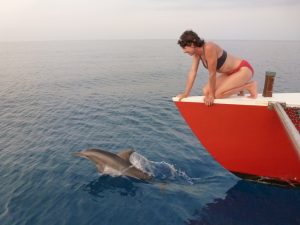
- One of those incredible cruising moments in the Java Sea in 2012
Best cruising moment:
There are so many wonderful times, but two stand out and they both have to do with our relationship.
The first was the day we met… in person. We’d first connected on the 7knots.com sailing crew site. It wasn’t until 6 months later that Alene flew to Mexico to meet me. Via email, we’d determined that we weren’t compatible, but I was tired of sailing alone, Alene needed some sailing time, and Migration had an empty aft cabin.
Our first day out we were sailing slowly when a small pod of dolphins showed up. Alene grabbed her snorkel, shouted “I’ve always wanted to swim with dolphins!” and jumped overboard! I was stunned. I knew she was an adventurous gal, but this was something else. The boat was barely moving, so after recovering from the shock, I also jumped in and we both swam with the dolphins until the wind built a little and we thought it prudent to get back aboard. For the next hour, the dolphins stayed around Migration while we sat on the bow and talked. It was strange because we were sailing so slowly and there was no bow wave for them to play in. Finally, they all gathered at the bow and sped away. We looked at each other amazed — it was clear to us both that they had just come to say goodbye. About a half hour later a whale surfaced near us. Then, as we rounded a point bringing the wind aft, the wind built for a perfect reach into a beautiful bay. We dropped anchor under sail and watched a glorious Mexican sunset. Alene still wonders how I managed to arrange such a perfect first day.

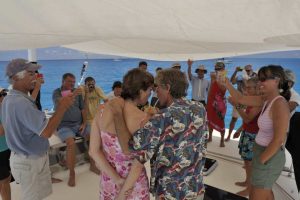
- The Wedding on board Migration at Minerva Reef – 9 November 2009
We got married 5 years later on the spur of the moment at Minerva Reef. I decided to propose (via a message in a bottle) and Alene said yes. There were several other boats anchored at Minerva waiting for a good weather window to head south to New Zealand. One of the boats were friends we’d known since Mexico (Betsy & Richard of SY Qayaq). When we told them we were engaged, they suggested we get married right there because the husband and wife on another boat were both captains and had recently married a couple at Suwarrow. So we invited the crews from all eight boats anchored in the reef and two days later got married under a big awning on Migration’s deck. The other yachties were wonderful; dressing their boats with flags, bringing us gifts and a bouquet of balloons, and baking wedding cakes. For our “reception” we raised anchor and took all our guests snorkeling outside the reef. We both agree that it couldn’t have been more perfect.
Favorite cruising area and why:
Easter Island stands out as one of the most fascinating places we’ve visited; the island is steeped in mystery. By moving from anchorage to anchorage, we were able to stay for five weeks and loved every minute of it.

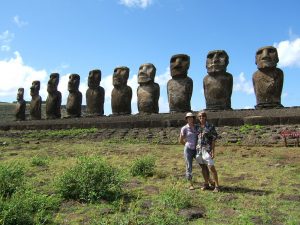
- Easter Island – 2008
The Tuamotus are also one of our favorite places. The water is clear, and the marine environment is quite healthy, so snorkeling and diving are excellent. We love the people, the culture of music and dancing, and being able to visit remote islands where few boats go.
Favorite anchorage:
We spent a memorable ten days anchored by ourselves on the east end of Katiu in the Tuamotus. We snorkeled every day and began to recognize the fish. We were adopted by a few shark suckers who hung out on our hulls waiting for us to swim. We hiked on the motu. We did yoga. Played music. Life slowed down and it felt simply idyllic.
Favorite cruising app:
We love OpenCPN on the laptop and use it as our primary navigation tool. Of course, windy.com is very useful when we have the internet. Also, fastseas.com is a nice tool for passage planning.
Favorite cruising websites:
Noonsite, for sure. We really appreciate other cruisers sharing their experiences about places off the normal routes. It helps a great deal to have some idea what to expect – especially with unknown issues of bureaucracy, changing regulations, and finding anchorages when there aren’t many to choose from.
We’ve also found useful information at hackingfamily.com and soggypaws.com.
We don’t read other cruisers’ blogs very often… we don’t even have time to keep our own website up to date! Both of us feel that the current focus on social media and video blogs is a bit antithetical to what we love about cruising. Part of the real joy of this life is disconnecting from all the busyness engendered by being tied to a device or a screen.

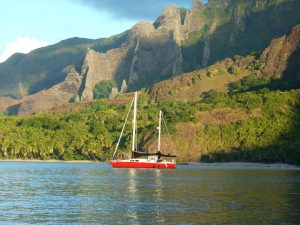
- Migration in the Marquesas, French Polynesia – 2009
Favorite cruising books:
Bruce: The Dove started it all for me when I read it at age 14.
Alene: Give Me The World, by Leila Hadley.
What advice or message would you want to pass on to anyone new to cruising or thinking about casting off the dock lines?
Bruce: Do it sooner than later. In the early ’80s, when I was 24, two friends and I signed on as crew on a Piver trimaran that was to sail from San Diego to the UK. The owner was a retired RAF officer and it had been his dream for many years. He was a real character; full of life, 70 going on 50. We had a big storm on the way down the Baja coast and he got very ill. He flew back to the US from Cabo San Lucas and went into the hospital while we took care of the boat. When he finally returned he was 70 going on 90; he’d realized he would not be able to make the voyage and his dream had died. That’s when I made the decision that I wouldn’t wait until I was retired to go cruising.
Alene: Similarly, I decided in my mid-20’s that I would begin cruising by age 40. Most people said it would be impossible, but I worked hard, saved as much as I could, and found a good financial planner. I don’t regret that effort to get out cruising sooner than later. This lifestyle isn’t for everyone, but if it’s your dream, then pursue it with a passion and don’t let the naysayers or fearmongers have their way.
We would both add that one shouldn’t wait for all the projects to be ticked off before you go. The list is never-ending, so do what’s necessary to create a safe, well-found boat… and go!
Why cruise? In a few sentences, what is it that inspires you to keep cruising?
The gratification of being wholly immersed in nature on a daily basis, the satisfaction of sailing our home safely across the sea using a minimum of carbon fuels, the beauty and serenity of being at anchor on our own personal island, the camaraderie of sailors the world over, and the adventure of visiting places unreachable by any other means.

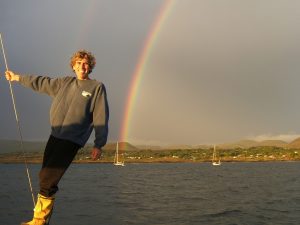
- Easter Island – 2008
Any other comments:
We feel that we are, in a small way, ambassadors for our country. We try to make friends wherever we go as there is so much to learn from the way other people live and think. We would like the people we meet to recognize that there are citizens of the USA interested in the world outside our own borders.
Most importantly, being at sea and on the water, nearly all the time gives us an especially deep appreciation for our planet, the creatures that it nurtures and the beauty of this great interconnected system. We are devastated by the abuse humankind heaps on the planet and that we see more directly than most: from overfishing to plastic waste to destruction of reefs and pristine habitats.
We think it is everyone’s responsibility to do what we can to stop the exploitation and ill-treatment of our only home. We are part of a greater whole that we should respect and care for.
Related to following destinations: USA
Related to the following Cruising Resources: Circumnavigation, Portrait of a Cruiser



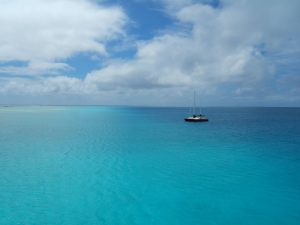


Looking forward to seeing Bruce and Alene back in New Zealand ! Perhaps Bruce’s children’s story inspired me to sail in the Haida Gwaii islands in Western Canada last month and finding ringing buoy with a seal eyeing it up for a rest I though of them. – Sharron Beck, Whangarei Marina manager.